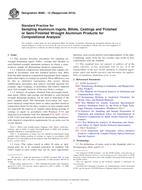Potřebujeme váš souhlas k využití jednotlivých dat, aby se vám mimo jiné mohly ukazovat informace týkající se vašich zájmů. Souhlas udělíte kliknutím na tlačítko „OK“.
ASTM B985-12(2016)
Standard Practice for Sampling Aluminum Ingots, Billets, Castings and Finished or Semi-Finished Wrought Aluminum Products for Compositional Analysis
Přeložit název
NORMA vydána dne 1.11.2016
Informace o normě:
Označení normy: ASTM B985-12(2016)
Poznámka: NEPLATNÁ
Datum vydání normy: 1.11.2016
Kód zboží: NS-667099
Počet stran: 8
Přibližná hmotnost: 24 g (0.05 liber)
Země: Americká technická norma
Kategorie: Technické normy ASTM
Kategorie - podobné normy:
Anotace textu normy ASTM B985-12(2016) :
Keywords:
Available from The Aluminum Association, Inc., 1400 Crystal Drive Suite 430 Arlington, VA 22202, ,, ICS Number Code 77.150.10 (Aluminium products)
Doplňující informace
| Significance and Use | ||||||||||||||
|
5.1 Products covered by this practice are unwrought aluminum ingots, billets, and castings and unclad wrought aluminum sheet, plate, rolled or cold finished extrusions, extruded profiles, wire, rod and bar. Machined wrought products (finished or semi-finished) are excluded (see Note 3). These practices, used in conjunction with the appropriate sample preparation techniques in Practices E716 and the Test Methods E34, E607, E1251, and EN 14242, are suitable to determine if the piece sampled meets the chemical composition limits registered with the Aluminum Association Inc.5 or other specified chemical composition limits for the alloy. Analysis of such samples shall not supersede the analysis of samples taken during pouring of castings or ingots in accordance with Practices E716 and analyzed in accordance with Test Methods E34, E607, E1251, or EN 14242 and shall not be used for determining compliance with chemical composition requirements for an entire cast lot or part thereof. Note 3: Sampling machined pieces of products pose a particular
problem because the piece itself may not be a representative sample
of the original cast chemical composition. Larger differences may
be expected between an analysis obtained from samples taken in
accordance with this practice and the original cast analysis of
samples taken during pouring of castings or ingot.
Note 4: Portable Spark-AES and hand held XRF instruments
should not be used to determine if the piece sampled meets chemical
composition limits registered with Aluminum Association Inc or
other specified chemical composition limits for the
alloy.
5.2 Users should be aware that chemical compositions determined using samples taken from unwrought aluminum ingots, billets, and castings and finished or semi-finished products might differ from the bulk chemical composition determined using samples taken when ingots or castings are poured. This difference can be due to elemental segregation upon solidification, sampling a non-homogenous section of the ingot or billet, removal of enriched material, or depleted areas of solidified material by subsequent procedures such as ingot scalping, the removal of risers from castings, or machining. Note 5: When aluminum solidifies, macro-segregation may cause
the chemical composition to vary throughout the ingot or casting.
Certain areas may have enhanced or depleted concentrations of some
elements relative to the average bulk chemical composition.
Remnants of the macro-segregation may be retained in finished and
semi-finished products. The sampling procedures described in this
practice are designed to provide a laboratory sample for analysis
which represents the chemical composition of the piece by taking
samples in a way that symmetrically includes the various enhanced
and depleted zones for example, sampling across the radius of a
round ingot, and so forth.
|
||||||||||||||
| 1. Scope | ||||||||||||||
|
1.1 This practice describes procedures for sampling unwrought aluminum ingots, billets, castings and finished or semi-finished wrought aluminum products to obtain a representative sample for determining chemical composition. 1.1.1 Chemical compositions determined from samples obtained in accordance with this standard practice may differ from the bulk chemical composition determined from samples taken when ingots or castings are poured. These differences can be due to elemental segregation that occurs during solidification, procedures that remove enriched material (for example, ingot scalping), or procedures that remove depleted areas (for example, removal of the riser from a casting). 1.1.2 Analysis of samples obtained from unwrought aluminum ingots, billets, and castings and finished or semi-finished wrought aluminum products can be used to determine if the piece sampled meets The Aluminum Association, Inc. registered chemical composition limits or other specified chemical composition limits for the alloy. Analysis of such samples shall not supersede the analysis of samples taken during pouring of castings or ingots in accordance with Practices E716 and analyzed in accordance with Test Methods E34, E607, E1251, or EN 14242 and shall not be used for determining compliance with chemical composition requirements for an entire cast lot or part thereof. Note 1: Pieces may include ingots, forgings, coils, sheets,
extrusions, castings, and so forth. A single unwrought ingot or
billet may produce multiple finished or semi-finished
pieces.
Note 2: Certification of entire cast lots should be determined
using samples taken during pouring of castings or ingots in
accordance with Practices E716 and analyzed in accordance with Test
Methods E34, E607, E1251, or EN 14242.
1.2 Units—The values stated in either SI units or inch-pound units are to be regarded separately as standard. The values stated in each system may not be exact equivalents; therefore, each system shall be used independently of the other. Combining values from the two systems may result in non-conformance with the standard. 1.3 This standard does not purport to address all of the safety concerns, if any, associated with its use. It is the responsibility of the user of this standard to establish appropriate safety and health practices and determine the applicability of regulatory limitations prior to use. |
||||||||||||||
| 2. Referenced Documents | ||||||||||||||
|
Doporučujeme:
Aktualizace zákonů
Chcete mít jistotu o platnosti užívaných předpisů?
Nabízíme Vám řešení, abyste mohli používat stále platné (aktuální) legislativní předpisy.
Chcete vědět více informací? Podívejte se na tuto stránku.




 Cookies
Cookies
